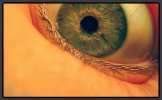Natural-scene statistics predict how the figure-ground cue of convexity affects human depth perception

The shape of the contour separating two regions strongly influences judgments
of which region is "figure" and which is "ground." Convexity and other
figure-ground cues are generally assumed to indicate only which region is
nearer, but nothing about how much the regions are separated in depth. To
determine the depth information conveyed by convexity, we examined natural
scenes and found that depth steps across surfaces with convex silhouettes are
likely to be larger than steps across surfaces with concave silhouettes. In a
psychophysical experiment, we found that humans exploit this correlation. For a
given binocular disparity, observers perceived more depth when the near
surface's silhouette was convex rather than concave. We estimated the depth
distributions observers used in making those judgments: they were similar to
the natural-scene distributions. Our findings show that convexity should be
reclassified as a metric depth cue. They also suggest that the dichotomy
between metric and nonmetric depth cues is false and that the depth information
provided many cues should be evaluated with respect to natural-scene
statistics. Finally, the findings provide an explanation for why figure-ground
cues modulate the responses of disparity-sensitive cells in visual cortex.
Download: pdf
Text Reference
Johannes Burge, Charless C. Fowlkes, and Martin S. Banks.
Natural-scene statistics predict how the figure-ground cue of convexity affects human depth perception.
Jounral of Neuroscience, 30(21):7269–7280, 2010.
BibTeX Reference
@article{BurgeFB_JON_2010,
AUTHOR = "Burge, Johannes and Fowlkes, Charless C. and Banks, Martin S.",
TITLE = "Natural-scene statistics predict how the figure-ground cue of convexity affects human depth perception",
JOURNAL = "Jounral of Neuroscience",
VOLUME = "30(21)",
YEAR = "2010",
pages = "7269-7280",
TAG = "ecological_statistics"
}
